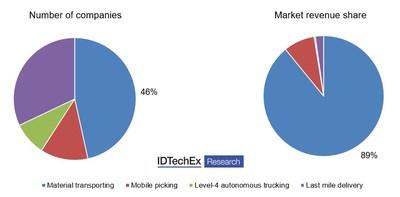BOSTON, March 9, 2022 /PRNewswire/ — X-as-a-Service business models are now commonplace in the industry, involving the delivery of a specific service rather than a product to perform the service. The most significant change in models such as this is the replacement of a proportionally very large up-front product price with a billing structure that is based on the services performed as the product itself. This is particularly relevant in robotics; customers of robotics-as-a-service (RaaS) business models can get the benefits of robotic process automation by leasing robotic devices and accessing a cloud-based subscription service rather than purchasing the equipment outright. The headaches of ownership, such as paying off an expensive piece of equipment plus handling maintenance issues that spring up, are avoided with RaaS.

RaaS is becoming an increasingly popular option, especially for mobile robotics in logistics. In the research for IDTechEx’s newest report “Mobile Robotics in Logistics, Warehousing and Delivery 2022-2042”, IDTechEx discovers 6-8% of the current market revenue for mobile robotics in logistics comes from RaaS model, according to the information and sources IDTechEx learned from industrial interviews. IDTechEx was also informed by some companies that they expected RaaS sales to grow in the future, as they had received increased requests for RaaS.
IDTechEx reveals that intralogistics material transporting robots, like AGVs and AMRs, dominate the biggest share of the logistic mobile robotics market. There are three biggest advantages of choosing RaaS for adopting mobile robots in warehouses.
Low cost of entry
Even though the upfront cost of implementing mobile robots is usually much less than that of installing complex fixed automation systems, some small and medium-sized enterprises may not be able to afford to complete the system initialization of mobile robotics at once. For instance, to fully automate the “goods-to-person” process in a 5000m2 warehouse, 200 grid-based automated guided carts (AGCs) could be needed, and the installation cost can be $4-4.5 million if software and customized shelves are also counted in. However, like all X-as-a-Service models, the billing of RaaS can be based on a monthly subscription or a pay-as-you-go model. In this case, customers can utilize the service without investing too much at the beginning and will have fewer losses if they stop operating the mobile robotic system.
Flexibility
In many industries, agile and lean operations are always desired; companies should be able to change operations or productions rapidly in response to market changes. RaaS allows customers to start or end mobile robotic systems at any time point as needed, and also allows changing product types quickly, for example, transferring from “shelve-to-person” grid-based AGCs to “carton-to-person” case picking robots easily.
Scalability
As described in the report “Mobile Robotics in Logistics, Warehousing and Delivery 2022-2042”, scalability is one of the most important strengths compared to fixed automation. However, RaaS enables scaling the fleet size to be even more convenient and easier, without concerning about the risks of reducing the fleet size in the future. For example, at sales peaks (e.g., Black Friday and other shopping festivals) temporary workers are often needed in warehouses to fulfill the surged demand. However, due to the global labor shortage, recruitment for temporary positions has become very challenging. RaaS of mobile robots can address this issue cost-effectively by expanding the service size to increase capacity and productivity for only a short period of time.
In the meanwhile, RaaS may bring benefits to mobile robotics companies as well. RaaS help increase customer stickiness by continuously providing service to customers, potentially creating more values and opportunities in the long term. It also helps maintain a good relationship with customers, making marketing and promotion easier for new products. Furthermore, companies can receive direct feedback from customers by providing RaaS to improve and accelerate product development.
To find out more about the current market landscape and 20-year market outlook of intralogistics material transporting robots, mobile picking robots, autonomous trucks delivery robots and drones, please see “Mobile Robotics in Logistics, Warehousing and Delivery 2022-2042”. Sample pages are available for all IDTechEx reports, please contact Research@IDTechEx.com to find out more.
About IDTechEx
IDTechEx guides your strategic business decisions through its Research, Subscription and Consultancy products, helping you profit from emerging technologies. For more information, contact research@IDTechEx.com or visit www.IDTechEx.com.
Images download:
https://www.dropbox.com/sh/jau1973o5imlmn9/AACCPPiTedO1tb312LN7Lgeda?dl=0
Media Contact:
Natalie Moreton
Digital Marketing Manager
press@IDTechEx.com
+44(0)1223 812300
Social Media Links:
Twitter: https://www.twitter.com/IDTechEx
LinkedIn: https://www.linkedin.com/company/idtechex/
Facebook: https://www.facebook.com/IDTechExResearch


View original content to download multimedia:https://www.prnewswire.com/news-releases/6-8-of-market-revenue-comes-from-raas-for-mobile-robotics-in-logistics-idtechex-analyzes-301499118.html
SOURCE IDTechEx
Credit: Source link





















